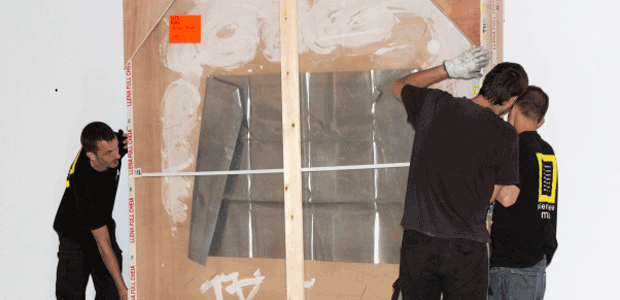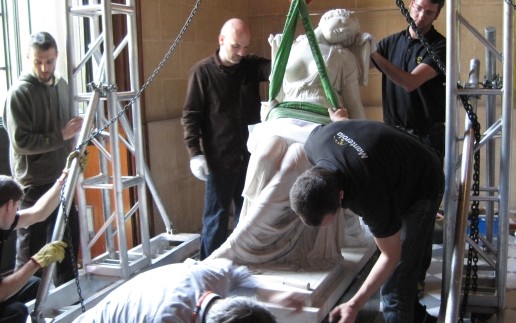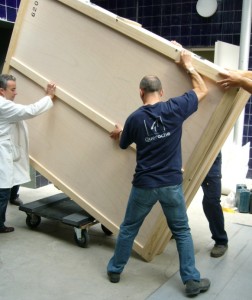
One of the considerations that is frequently overlooked in the handling of works of art, besides technical considerations, is the attitude that art handlers have to take when approaching their work. The peculiar nature of this profession makes necessary not just technical expertise, but also an understanding of it as another link in the safeguarding of cultural patrimonies and in the success of museographies. It is a difficult task, then, transmitting an attitude to a profession that, although its technical aspects can be taught, the feeling for it is hard to learn. “The tao of handling” is a tribute to all those whose vocation has led them to the lesser echelons of art.
The tao of handling
- The best handling is that which is never done. Works of art, save for a few exceptions, were not designed to be handled.
- The best handler is one who is able to place himself in the middle ground of events.
- A handler speaks with his hands, it is true, but also with the torsion of his body, his composure, with rhythm and pauses. With his gaze too.
- The best of all possible handling will be that which gets closest to non-action. A handler of works of art manages silences.
- Works of art have structure, form and soul. A good handler has to bear in mind these three considerations in the handling process.
- If there are no eternally lasting phenomena of nature, how can art be a perennial asset? The beauty of some objects or artistic acts lies, precisely, in their scant durability. The art-handler must take this breath of art into consideration. He must become one with art’s subtle effort to cling to Time.
- Handling art objects is not a dishonourable act. It is just as important to change, at the right time, the engine oil of the lorry that is going to transport the art object inside it, as it is to restore the paint layer of the masterpieces of art history.

- In a team of handlers, the supervisor should not impose himself on the other members. All the handlers have to become one with the work of art. The art handler has to become one with the work and with the collateral materials that surround the handling process.
- Do not approach a work of art with fear. Seek the middle ground between caution and determination. The conscious art handler realizes that what others fear about the object is not really fearsome. Those who do not know the tao of handling impose limits on the object. The conscious handler can see the infinite qualities of the object and the act.
- “The difficult and the easy mutually blend with one another.” Part of the secret of a good handling comes from the liberation of the desire to handle properly. By not seeking, it is obtained.
- An art-handler must know the work of art’s tao. He has to manage the torsion, the rhythms and the stillness of all the materials with which he works.
- After handling, the art-handler must withdraw. “Make your ego smaller and limit your desires.” Erase yourself from the memory of the acts and your attitude will remain adhering to them.
- A handler must be transparent before, during and after his action. The art handler’s speech is governed by silence. Virtuous handling goes unnoticed.
- Art is not the right place for doctrines, for it is a breeding ground of paradoxes. The handling of works of art cannot be, therefore, an exact science. Nor is it merely a technique.
- “Use the heavy in its lightness.” The most complex handling is easy in principle. The wise art-handler deems all handling difficult, and never encounters difficulties.
- The handler who wishes to mould objects ends up breaking them. The voids mould the object. The actions of the art handler must unite with the voids. Non-action governs all good handling. “The weak and the fragile overcome the hard and the strong.”
- Behind every work of art there is a human being.
- “Every action causes a reaction.” Knowing the path of the middle ground, knowing the equidistance between the object and non-action generates equilibriums.
- Non-action is the highest virtue of handling. Not seeking virtue in handling, non-intention is what places the art-handler in the precise non-place. “Learn the teachings of silence.”
- “The heavy guides the light. The immobile is the master of movement.” All handling is governed by an axis on which actions and objects spin. This axis makes it possible for everything to remain at rest although it moves. The conscious art-handler seeks to seize the axis on which the actions and objects remain at rest.
 Only by not-being can the conscious hander of works of art penetrate the impenetrable nature of a handling. The art handler triumphs when he practises renunciation. He who pursues successes never triumphs. He who pursues the success of art, does not reach Art.
Only by not-being can the conscious hander of works of art penetrate the impenetrable nature of a handling. The art handler triumphs when he practises renunciation. He who pursues successes never triumphs. He who pursues the success of art, does not reach Art.- The secret of wise handling consists in being able to stop when enough is enough. The practice of tao is the intimate refuge of the art-handler. It is a transparent art. It is an act in which to dissolve one self. To balance oneself in non-action.
- Works of art perish. Noble objects perish. The most ignoble materials perish. Actions fade away. Ideas perish. Men perish. He who knows the harmony of the void, knows the long-lasting.
- All objects deserve to be treated as works of art.
- Learning the intangible is part of the art-handler’s tao. Knowing the nature of objects and not forcing it cannot be learnt, only known.
- “Everything that reaches plenitude begins to decline.” The tao of handling seems insipid and yet achieving it is the art-handler’s ultimate goal.
- Everyone can be a good art-handler if they know the tao of handling. If one acquires the work of art, with the collateral elements, with the acts and the breath of Art.
- The art of the tao savours the insipid. “Find greatness in the little things.”
Have you ever stopped to think that everything in a museum is always in motion? Do you believe that the arrangement in the galleries can alter the contents, the soul of the work of art? Would you add anything else to the list?
Mediació i Programació Cultural







